Related Research Articles

Arable land is any land capable of being ploughed and used to grow crops. Alternatively, for the purposes of agricultural statistics, the term often has a more precise definition:
Arable land is the land under temporary agricultural crops, temporary meadows for mowing or pasture, land under market and kitchen gardens and land temporarily fallow. The abandoned land resulting from shifting cultivation is not included in this category. Data for 'Arable land' are not meant to indicate the amount of land that is potentially cultivable.

A plough or plow is a farm tool for loosening or turning the soil before sowing seed or planting. Ploughs were traditionally drawn by oxen and horses, but in modern farms are drawn by tractors. A plough may have a wooden, iron or steel frame, with a blade attached to cut and loosen the soil. It has been fundamental to farming for most of history. The earliest ploughs had no wheels; such a plough was known to the Romans as an aratrum. Celtic peoples first came to use wheeled ploughs in the Roman era.
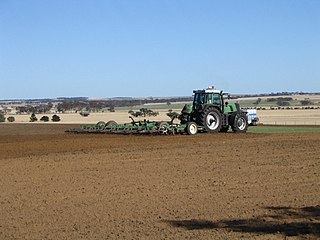
Tillage is the agricultural preparation of soil by mechanical agitation of various types, such as digging, stirring, and overturning. Examples of human-powered tilling methods using hand tools include shoveling, picking, mattock work, hoeing, and raking. Examples of draft-animal-powered or mechanized work include ploughing, rototilling, rolling with cultipackers or other rollers, harrowing, and cultivating with cultivator shanks (teeth).

Crop rotation is the practice of growing a series of different types of crops in the same area across a sequence of growing seasons. It reduces reliance on one set of nutrients, pest and weed pressure, and the probability of developing resistant pests and weeds.
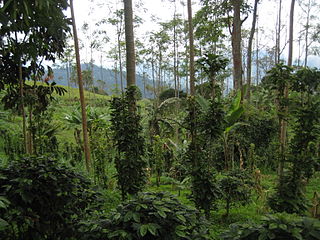
Sustainable agriculture is farming in sustainable ways meeting society's present food and textile needs, without compromising the ability for current or future generations to meet their needs. It can be based on an understanding of ecosystem services. There are many methods to increase the sustainability of agriculture. When developing agriculture within sustainable food systems, it is important to develop flexible business process and farming practices. Agriculture has an enormous environmental footprint, playing a significant role in causing climate change, water scarcity, water pollution, land degradation, deforestation and other processes; it is simultaneously causing environmental changes and being impacted by these changes. Sustainable agriculture consists of environment friendly methods of farming that allow the production of crops or livestock without damage to human or natural systems. It involves preventing adverse effects to soil, water, biodiversity, surrounding or downstream resources—as well as to those working or living on the farm or in neighboring areas. Elements of sustainable agriculture can include permaculture, agroforestry, mixed farming, multiple cropping, and crop rotation.
The stale seed bed or false seed bed method is a weed control technique used at both the farm and garden scales. In this that the young weeds can then be easily eliminated. By destroying them early, the farmer or gardener eliminates most of that season's annual weeds, which reduces their labor and improves their crop yields.

Weed control is a type of pest control, which attempts to stop or reduce growth of weeds, especially noxious weeds, with the aim of reducing their competition with desired flora and fauna including domesticated plants and livestock, and in natural settings preventing non native species competing with native species.
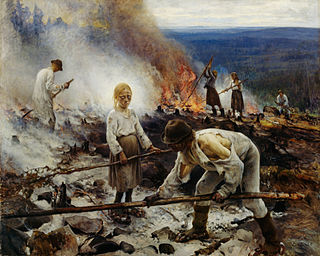
Slash-and-burn agriculture is a farming method that involves the cutting and burning of plants in a forest or woodland to create a field called a swidden. The method begins by cutting down the trees and woody plants in an area. The downed vegetation, or "slash", is then left to dry, usually right before the rainiest part of the year. Then, the biomass is burned, resulting in a nutrient-rich layer of ash which makes the soil fertile, as well as temporarily eliminating weed and pest species. After about three to five years, the plot's productivity decreases due to depletion of nutrients along with weed and pest invasion, causing the farmers to abandon the field and move to a new area. The time it takes for a swidden to recover depends on the location and can be as little as five years to more than twenty years, after which the plot can be slashed and burned again, repeating the cycle. In Bangladesh and India, the practice is known as jhum or jhoom.
A sapric is a subtype of a histosol where virtually all of the organic material has undergone sufficient decomposition to prevent the identification of plant parts. Muck is a sapric soil that is naturally waterlogged or is artificially drained.

In agriculture, a green manure is a crop specifically produced to be incorporated into the soil while still green. Typically, the green manure's biomass is incorporated with a plow or disk, as is often done with (brown) manure. The primary goal is to add organic matter to the soil for its benefits. Green manuring is often used with legume crops to add nitrogen to the soil for following crops, especially in organic farming, but is also used in conventional farming.
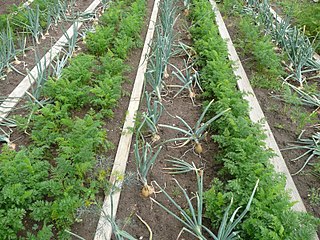
In agriculture, polyculture is the practice of growing more than one crop species in the same space, at the same time. In doing this, polyculture attempts to mimic the diversity of natural ecosystems. Polyculture is the opposite of monoculture, in which only one plant or animal species is cultivated together. Polyculture can improve control of some pests, weeds, and diseases while reducing the need for pesticides. Intercrops of legumes with non-legumes can increase yields on low-nitrogen soils due to biological nitrogen fixation. However, polyculture can reduce crop yields due to competition between the mixed species for light, water, or nutrients. It complicates management as species have different growth rates, days to maturity, and harvest requirements: monoculture is more amenable to mechanisation. For these reasons, many farmers in large-scale agriculture continue to rely on monoculture and use crop rotation to add diversity to the system.

No-till farming is an agricultural technique for growing crops or pasture without disturbing the soil through tillage. No-till farming decreases the amount of soil erosion tillage causes in certain soils, especially in sandy and dry soils on sloping terrain. Other possible benefits include an increase in the amount of water that infiltrates into the soil, soil retention of organic matter, and nutrient cycling. These methods may increase the amount and variety of life in and on the soil. While conventional no-tillage systems use herbicides to control weeds, organic systems use a combination of strategies, such as planting cover crops as mulch to suppress weeds.
Biointensive agriculture is an organic agricultural system that focuses on achieving maximum yields from a minimum area of land, while simultaneously increasing biodiversity and sustaining the fertility of the soil. The goal of the method is long term sustainability on a closed system basis. It is particularly effective for backyard gardeners and smallholder farmers in developing countries, and also has been used successfully on small-scale commercial farms.

Soil conservation is the prevention of loss of the topmost layer of the soil from erosion or prevention of reduced fertility caused by over usage, acidification, salinization or other chemical soil contamination.

Worldwide more human beings gain their livelihood from agriculture than any other endeavor; the majority are self-employed subsistence farmers living in the tropics. While growing food for local consumption is the core of tropical agriculture, cash crops are also included in the definition.
Tile drainage is a form of agricultural drainage system that removes excess sub-surface water from fields to allow sufficient air space within the soil, proper cultivation, and access by heavy machinery to tend and harvest crops. While surface water can be drained by pumping, open ditches, or both, tile drainage is often the most effective means of draining subsurface water.
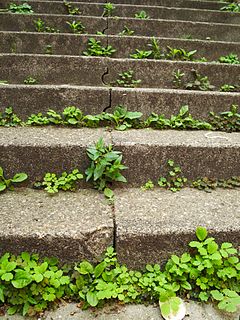
A weed is a plant considered undesirable in a particular situation, "a plant in the wrong place", or a plant growing where it is not wanted. This introduces the concept of humans and their goals in a particular setting. The concept of weeds is particularly significant in agriculture, where the aim is growing crops or pastures of a single species, or a mixture of a few desired species. In such environments, other plant species are considered undesirable and therefore a weed. Besides, some weeds have undesirable characteristics making them a plant pest in most human settings.
Indigenous horticulture is practised in various ways across all inhabited continents. Indigenous refers to the native peoples of a given area and horticulture is the practice of small-scale intercropping.

Micro-irrigation, also called Micro-spray,localized, low-volume, low-flow, or trickle irrigation, is an irrigation method with lower water pressure and flow than a traditional sprinkler system. Low-volume irrigation is used in agriculture for row crops, orchards, and vineyards. It is also used in horticulture in wholesale nurseries, in landscaping for civic, commercial, and private landscapes and gardens, and in the science and practice of restoration ecology and environmental remediation. The lower volume allows the water to be absorbed into slow-percolation soils such as clay, minimizing runoff.
This glossary of agriculture is a list of definitions of terms and concepts used in agriculture, its sub-disciplines, and related fields. For other glossaries relevant to agricultural science, see Glossary of biology, Glossary of ecology, Glossary of environmental science, and Glossary of botany.